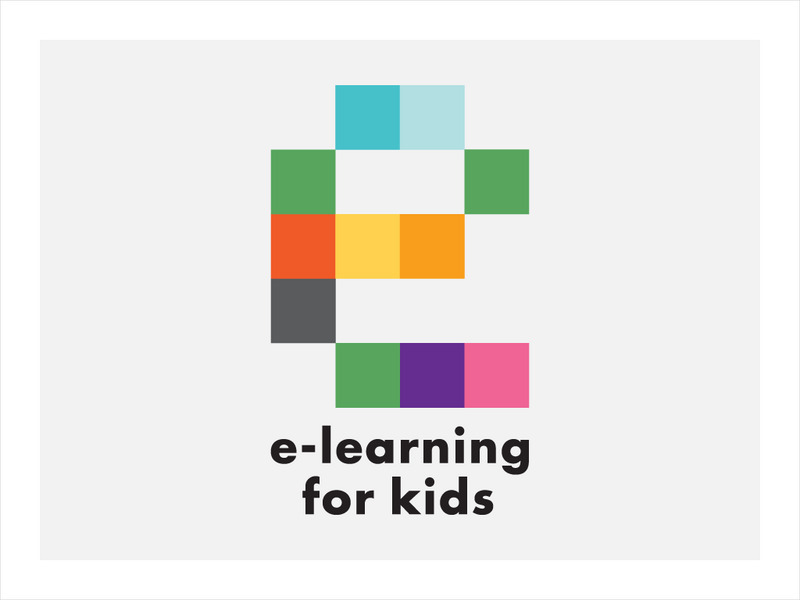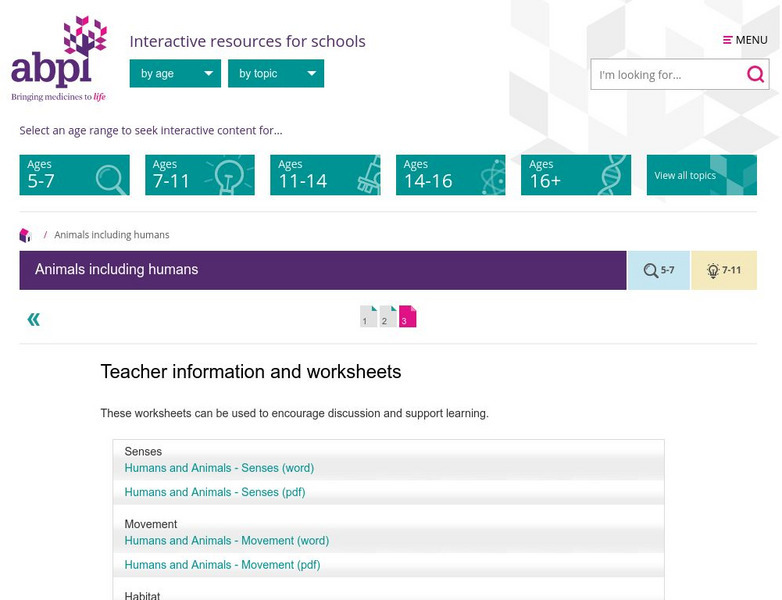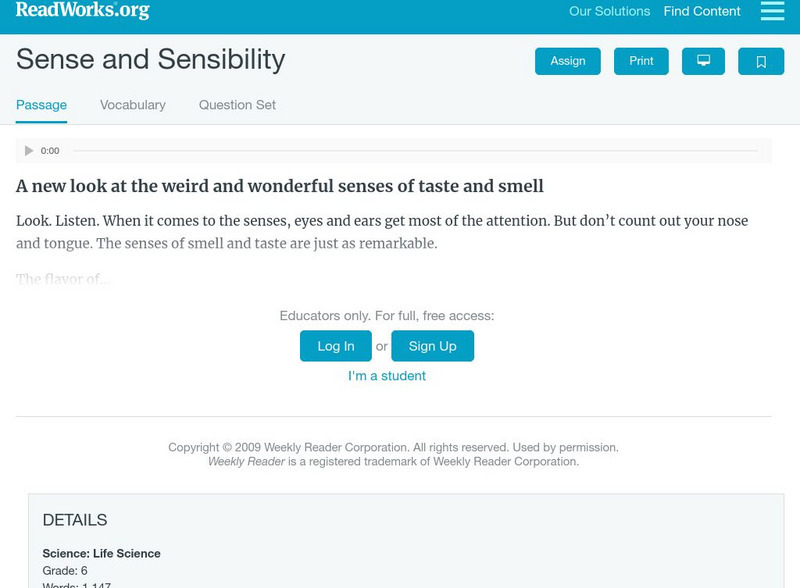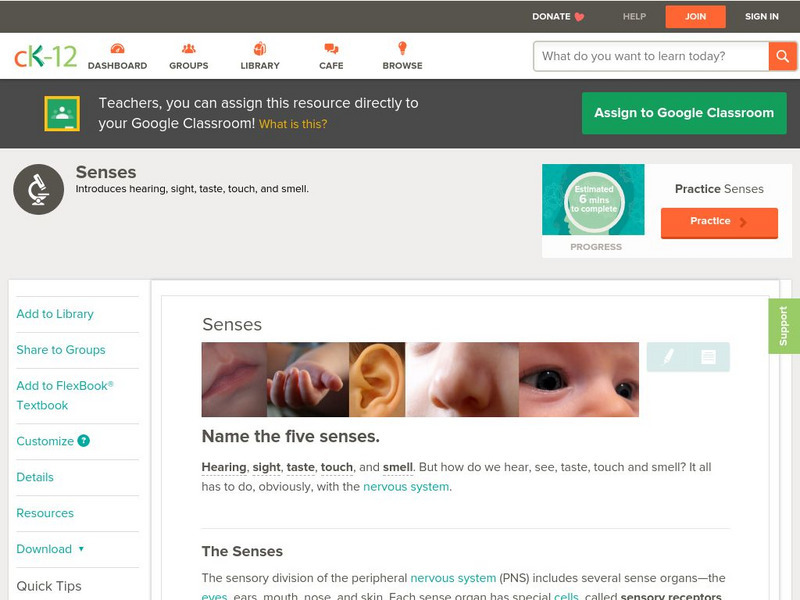TED Talks
Ted: Ted Ed: What Color Is Tuesday? Exploring Synesthesia
How does one experience synesthesia- the neurological trait that combines two or more senses? Synesthetes may taste the number 9 or attach a color to each day of the week. Richard E. Cytowic explains the fascinating world of entangled...
Other
Alley Dog: Psychology Class Notes: Sensation and Perception
The study of psychophysics is the psychological perception of the physical experiences of sensations humans encounter. These notes detail the science behind the two sciences and dives into the way they work together.
Other
Biology Online: Human Physiology: Sensory Systems
Study the many parts of the human body that make up the sensory systems. Be able to identify receptors, primary sensory coding, neural pathways and more with this biology resource.
McGraw Hill
Glencoe Biology: The Senses: Self Check Quiz
Five multiple-choice quiz questions covering the senses. Students have the opportunity to check their answers after submitting their results.
The Franklin Institute
In Quiry Almanack: Touching
Let your students get a feel for their sense of touch by perusing this site. Site includes interactive activities to use in the classroom.
Frontiers Media
Frontiers: Seeing With Your Ears: A Wondrous Journey Across the Senses
For dozens of years it has been believed that the brain is organized into "sensory areas": that is, that there is a "visual area," an "auditory area," and so forth, and that the visual area can only process visual information. It has...
PBS
Pbs Teachers:wild Places: Follow Your Nose
Explore the migration behavior of various animals, and investigate the sense of smell as a tracking device for these migrations. Emulate salmons by following and scented path, and construct a map of the "river" as you head "upstream."
PBS
Pbs Teachers: Scientific American: The Wonder Pill: Placebo 1
Investigate how the brain can be fooled into incorrectly processing sensory information. Conduct an experiment to fool someone into thinking you've touched his or her hand.
E-learning for Kids
E Learning for Kids: Cayman Islands: Turtle Beach: What Controls Our Body?
This lesson explains how the five senses work together with the nervous system and the brain to give us essential information about the world around us.
Grammar Check
Grammar Check: How to Write a Descriptive Essay
This article provides seven steps to follow when writing a descriptive essay. Ideas for ways to incorporate sensory details are emphasized. W.9-10.3d Precise/sensory details
The Association of the British Pharmaceutical Industry
Abpi: Active Science Modules: Humans and Animals Worksheets
Activities to accompany the Active science learning modules.
TeachEngineering
Teach Engineering: Solid, Liquid or Gas?
Students are given a variety of materials and asked to identify if each material as a solid, liquid or gas. They use their five senses - sight, sound, smell, texture and taste - to identify the other characteristics of each item.
Read Works
Read Works: Sensing the World Around Us
[Free Registration/Login Required] An informational text about the five senses. A question sheet is available to help students build skills in reading comprehension.
Read Works
Read Works: Sense and Sensibility
[Free Registration/Login Required] An informational text about the sense of smell and the sense of taste. A question sheet is available to help students build skills in reading comprehension.
Other
Neurociencias Para Ninos / Neuroscience for Kids
Learn about the brain and brain science using this Spanish version of the excellent Neuroscience for Kids site. Translation of the site is a work in progress. Portions are in Spanish but links for many pages still lead to the English...
Other
Writing World: Four Ways to Bring Settings to Life
A great resource outlining four major ways to make settings appear more real and genuine in fiction. Deals with themes such as motion, experience, mood, and the senses. W.11-12.3d Sensory/precise lang narratives
The Wonder of Science
The Wonder of Science: 4 Ls1 2: Sensation, Processing, and Response
Work samples, phenomena, assessment templates, and videos that directly address standard 4-LS1-2: sensation, processing, and response.
CK-12 Foundation
Ck 12: Life Science: Taste and Smell
[Free Registration/Login may be required to access all resource tools.] Imagine you open a gallon of milk, and you suddenly smell a foul odor. Your sense of smell has informed you that the milk has spoiled. So you pour the spoiled milk...
CK-12 Foundation
Ck 12: Life Science: Touch
[Free Registration/Login may be required to access all resource tools.] It might sound good to you to have a condition where you feel no pain. But actually this type of condition would be very dangerous. What would happen if you strained...
CK-12 Foundation
Ck 12: Biology: Senses
[Free Registration/Login may be required to access all resource tools.] Discusses how sensory stimuli are perceived and interpreted.
Other
Simply Psychology: Visual Perception Theories
Bottom-Up Processing and Top-Down Processing are two schools of thought when scientists discuss how humans perceive the senses which they experience. This article explores the two theories of visual perception and cites evidence and...
Other
Siemens Science Day: Life Science: Fifth Sense
A hands-on science activity where students will explore how the body uses the five senses to make decisions.
Other
Child Mind Institute: Treating Sensory Processing Issues
This article looks at ways to address sensory processing disorders with therapy. The idea behind SI therapy is that specific movement activity, resistive bodywork, and even brushing of the skin can help a child with sensory problems...
Alabama Learning Exchange
Alex: Sense Suspense
For this language development lesson, Kindergarten ELLs learn the five senses, classify objects using the five senses, and create an ABC book modeled after Bruce McMillan's Sense Suspense in which they demonstrate their learning.






















